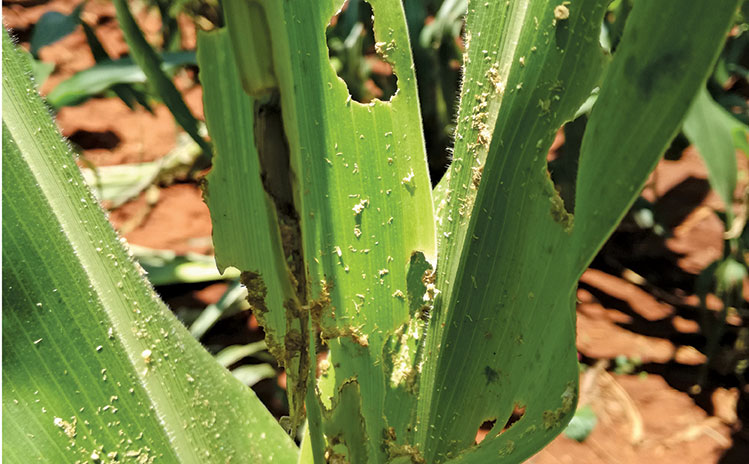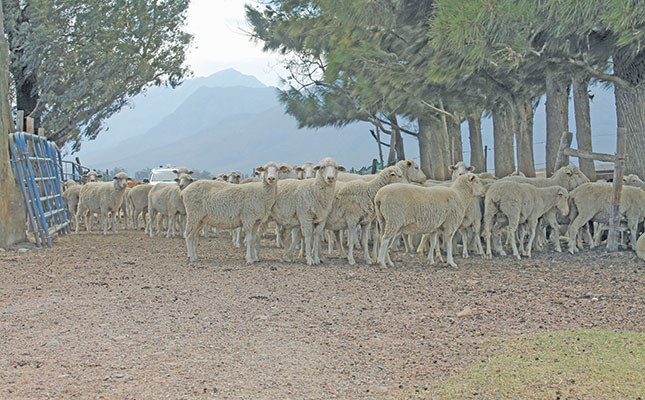
Photo: Dr Annemie Erasmus
Fall armyworm (FAW) was first discovered in South Africa in 2017, with outbreaks and damage to maize crops reported in North West and Limpopo. Since then, the pest has also been reported on potato crops in Mpumalanga.
READ Using bats and birds to control macadamia crop pests
According to the UN’s Food and Agriculture Organization, FAW (Spodoptera frugiperda) is an insect native to tropical and subtropical regions of the Americas. In its larval stage, it causes significant damage to crops.
Despite its preference for maize, the larvae feed on more than 80 species of plants, including rice, sorghum, millet, sugar cane, vegetable crops and cotton. However, it has a definite preference for grass crops and would probably target these crops solely if they were continuously available.
Since 2016, it has spread throughout sub- Saharan Africa.
A local solution
The discovery of an indigenous egg parasitoid that feeds on FAW eggs, Telenomus remus, and its use together with chemical control measures, means that an integrated pest management system (IPM) for fall armyworm is possible in South Africa.
Despite this, FAW is a notoriously difficult insect pest to control in maize, and control is effective only if done while the larvae are small. Early detection and the proper timing of insecticide application are therefore critical.
READ Using insects as animal feed
The earlier the larvae are detected, the better, as the frass (larvae excrement) can create a ‘plug’ in the plant’s whorl, which prevents penetration of insecticide.
To control FAW, the insecticide must be used alongside the pest’s natural enemies. Insecticide application should always be used with care and attention to safety.
A farmer should ensure that the product is registered for control of the target pest, read the prescriptions on the label carefully, apply the correct dosage, use the correct water volume and the correct-sized nozzle, and apply the insecticide at the best time for optimal control.
Monitoring measures after application is essential to ensure that the pests are properly controlled. However, preventative spray applications are not recommended, as it is impossible to predict outbreaks, and could cause the pests to develop resistance to the insecticides. Instead, regular scouting and surveillance are the key in the fight against FAW.
Knowing the enemy
The lifecycle of the worm varies between 24 and 30 days, depending on prevailing temperature and humidity.
The number of generations occurring in a specific area is governed by the number of dispersing moths. This species does not have a diapause (overwintering) stage.
The eggs are dome-shaped with a flat base, and curve upward to a broadly round point. They occur in batches of variable size attached to foliage; up to 200 eggs have been recorded in a batch, and a female moth can lay more than 1 000 eggs in her lifetime.
READ Beneficial insects can help farmers control pests
The female deposits a layer of furry-looking, greyish scales over the batch. The egg stage generally lasts two to three days.
Newly hatched larvae are green, but the colour changes as they mature. The smooth-skinned larvae can be light tan or green to nearly black, with three yellow-white lines that run down the back.
Yellow lines with wider dark stripes alongside occur on each side of the FAW’s body. FAW can be differentiated from other species by a white, inverted Y-shape on the forehead between the eyes.
The duration of the larval stage can be as short as 14 days in summer. The FAW larvae feed day and night.
Pupation normally takes place in the soil, but the larvae can weave together leaf debris and pupate in this structure if the soil is too hard. The pupal stage lasts eight to 10 days, and takes place in summer.
After pupation, moths emerge from the cocoons. They are mainly nocturnal, and have a wingspan of 32mm to 40mm, making them strong fliers. The male’s forewings are coloured in shades of grey and brown, with triangular white spots at the tip and near the centre. The female’s forewings are less distinctly marked. The hind wings are silvery white in both sexes.
The duration of the adult stage is about 10 days.
Damage to maize
An infestation of larvae can result in large-scale leaf feeding, which can cause serious damage to maize whorls. Damage can also be caused to maize tassels and ears through direct feeding.
FAW larvae can harm maize in nearly all stages of development, but the larvae are particularly dangerous to maize plants that have not yet silked. The majority of damage is caused to pre-tassel maize.
READ Cotton can be more profitable than maize!
While maize plants often recover from whorl damage without any effect in yield, larvae can destroy young ears during tasselling, posing a greater threat to the ultimate yield.
Damage usually occurs in patches on a land.
Because of its wide host range, this species is one of the most harmful pests of annual crops in tropical regions. During the past two seasons in South Africa, FAW was also reported on potatoes, soya bean, sugar cane, wheat and sorghum.
Damage was minimal, however, and it is unknown whether FAW can complete its life cycle on these crops. Maize remains its preferred host, and serious damage of the crop has been reported.
Genetically modified maize
The Agricultural Research Council, in collaboration with North-West University, has conducted trials to determine larval susceptibility to Bt maize.
Larvae were placed into maize whorls of non-Bt maize plants (the control group), as well as into first-generation Bt maize commercialised in South Africa (Bt1) and second-generation Bt maize (Bt2).
Ninety-five percent of the larvae on the control maize plants survived after feeding for 14 days, 47% on Bt1 and 0% on Bt2 (see graph). It can be concluded that Bt1 will suppress FAW, while Bt2 has the potential to control larval infestation.
Integrated pest management
A number of parasitoids were reared from FAW larvae sampled from the lands, which led to the discovery of the FAW egg parasitoid.
This occurs naturally in South Africa, and is also used in the Americas as a biological agent, where it is reared and then released into lands to control the pest.
To implement an effective IPM, producers must ensure that they keep scouting their lands for possible invasions, and apply insecticides only when needed.
Email Dr Annemie Erasmus at [email protected].










